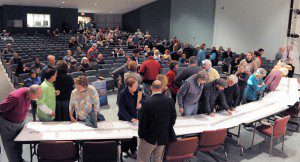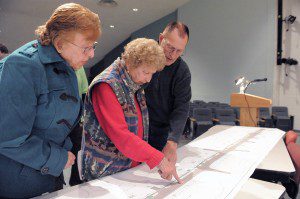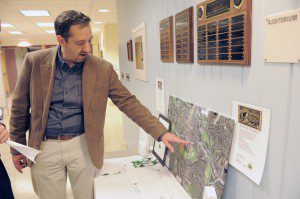
Residents gather around a set of tables to examine a set of drawings during the Western Avenue and Court Street Improvement Project informational meeting at Westfield South Middle School last night. (Photo by Frederick Gore)
WESTFIELD – Residents gathered for the third time Wednesday night to discuss the Western Avenue improvement project and for the third time there was little consensus.
The concerns are that the volume of traffic, when Westfield State University is in session, is 15,000 vehicular trips a day, and that students commuting to classes generate the vast majority of that traffic.
Another concern is the demographics of the motorists using Western Avenue. Traditional traffic studies do not provide accurate data on the Western Avenue motoring population because the age factors are skewed toward young adults.
And then there were reservations expressed about the design of the road improvement.
Some speakers supported installing traffic lights, some opposed that. Some speakers supported traffic islands and dedicated left turn lanes, others opposed that.
Two themes developed during the presentation. One is residents of that area want traffic slowed down, but doubt that any of the proposals presented last night will accomplish that because as one speaker said “19-year-old boys are going to do what they want to do.”
The second theme is that the problem is created by the growing student population of WSU that will make any city investment in restructuring Western Avenue a very short-term solution as the university continues to grow.

Rose Crawford, Beverly Crawford and Gerry Crawford, all residents of the Western Avenue area, examine a set of drawings of the proposed improvements that will be made to Western Avenue and Court Street during a public informational meeting last night at Westfield South Middle School. (Photo by Frederick Gore)
The third theme is that the university, not the city, should be solving the problem by constructing a road from the campus down to Route 20 (Russell Road) because that is why it purchased the former Sheraton Inn property.
One man quipped that the university should construct a parking lot on Route 20 and connect it to the campus by a chairlift and zip line, a proposal that might appeal to students.
Mayor Daniel M. Knapik said that solution was off the table because of the high cost, around $10 million.
Several residents questioned the total cost of the Western Avenue improvements which will now be performed in three phases, without key elements, such as a Western Avenue/Lloyds Hill Road traffic light which is being deleted from the current phase because of the cost and the fact that the total project improvements could be close to that $10 million number that the university balked at paying.
Phase one, being funded with a federal $2.5 earmark originally approved for the university road project down from the campus to Russell Road, and with city money of between $1 and $1.5 million will only encompass the section of Western Avenue between Lloyds Hill Road and Laura Drive.
Later phases will be improvements from Lloyds Hill eastward to the intersection of Mill, High, and Court streets, while another phase will be improvements from Laura Drive to Bates Road.
Phase 1 includes installation of conduits and wiring for a traffic light at Lloyds Hill and Laura Drive, but not the actual traffic signals because of the expense. Knapik said those signals could be installed later as deemed necessary.
Several speakers objected to the elimination of the traffic lights, stating that the lights will slow traffic and create breaks in the line of traffic needed to exit side streets.

Jeff LaValley, chairman of the Friends of the Columbia Greenway Rail Trail, explains the bike trail to visitors of the Western Avenue and Court Street Improvement Project informational meeting staged in the auditorium of the Westfield South Middle School last night. (Photo by Frederick Gore)
An asphalt sidewalk would be installed on the south side of the roadway from Laura Drive to Lloyds Hill and a concrete sidewalk on the north side of the roadway would be extended from the end of the present sidewalk in front of the Horace Mann building to Lloyds Hill.
The plan also calls for reducing the present 12-foot wide travel lanes to 11 feet, and possibly to 10 feet if the state grants a waiver, to force motorists to exercise more care and attention to their driving. Residents at past meetings have raised concerns about distracted driving on the part of the university students.
The narrower travel lanes increase the width of the shoulders that are intended to be available for bicyclists. The plan to construct a 10-foot wide multi-use path along the south side of the roadway for pedestrians and bicyclists was deleted from the third proposed plan because of resident opposition.
The dedicated 10-foot-wide left turn lanes remain as previously detailed with a number of different traffic island treatments, ranging from a raised structure, to textured (rumble strip) surfaces, to painted islands.
Four pedestrian crosswalks will be installed at Laura Drive, Lloyds Hill and in the area of Stanley Park.
Designers plan to remove 36 existing trees and plant 79 new trees to reestablish a tree belt canopy.
Brad Moir, a Western Avenue resident near Lloyds Hill, said the university has “over admitted” students and does not have sufficient on-campus housing, pushing students into the downtown area “which has created the traffic congestion.” Moir asked if the university would enhance its shuttle system to reduce the number of students driving to the campus.
Knapik said that the city “has pressed the university to get kids out of cars, to have a shuttle service” but that the university has not embraced that concept.
City Engineer Mark Cressotti said the city is trying to streamline the state's reconstruction of Western Avenue by putting in drainage, extending sewer mains and completing any other underground utility work before the road reconstruction effort begins.
Knapik received a round of jaded applause when he asked if the residents just wanted an overlay of pavement, a very short-term solution without the addition of new drainage to remove stormwater.
Residents circulated a petition prior to the meeting seeking to put the project forward as a referendum question and give city residents an opportunity to decide if the reconstruction project was supported.
One woman also drew applause when said she “wants Western Avenue back” and the only way to achieve that is to reduce university-generated traffic by installing an access road from Russell Road.
“I don't get all of this,” she said, “I do want to know why the property on Route 20 is not a viable option.”

